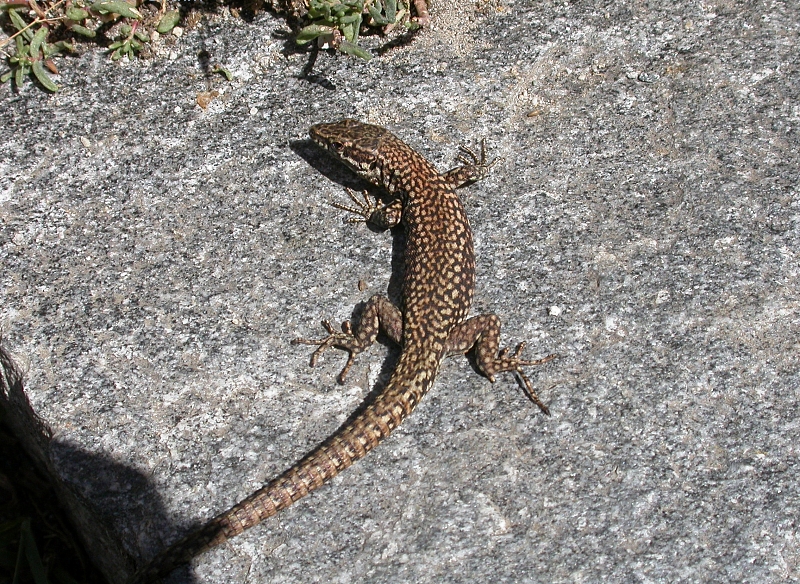- Italian Wall Lizard
Taxobox
name = Italian Wall Lizard

status = LC | status_system = IUCN3.1
regnum =Animalia
phylum =Chordata
classis =Reptilia
ordo =Squamata
familia =Lacertidae
genus = "Podarcis "
species = "P. sicula"
binomial = "Podarcis sicula"
binomial_authority = (Rafinesque, 1810)
synonyms = "Podarcis siculus"
(Rafinesque, 1810)The Italian Wall Lizard or Ruin Lizard ("Podarcis sicula") is a species of
lizard in theLacertidae family. "P. sicula" is found inBosnia and Herzegovina ,Croatia ,France ,Italy ,Serbia andMontenegro ,Slovenia ,Spain ,Switzerland ,Turkey , and theUnited States .Isailovic, J.C., Vogrin, M., Corti, C., Mellado, V.P., Sá-Sousa, P., Cheylan, M. & Pleguezuelos, J. 2005. [http://www.iucnredlist.org/search/details.php/61553/all Podarcis sicula] . [http://www.iucnredlist.org 2006 IUCN Red List of Threatened Species] . Downloaded on 28 July 2007.] "P. sicula" belongs to theSquamata family of lizards and it is the most abundant lizard species in southernItaly .cite journal |author=De Falco M, Sciarrillo R, Virgilio F, "et al" |title=Annual variations of adrenal gland hormones in the lizard Podarcis sicula |journal=J. Comp. Physiol. A Neuroethol. Sens. Neural. Behav. Physiol. |volume=190 |issue=8 |pages=675–81 |year=2004 |month=August |pmid=15170520 |doi=10.1007/s00359-004-0528-1 |url=]Its natural
habitat s are temperateforest s, temperateshrubland , Mediterranean-type shrubby vegetation, temperategrassland , rocky areas, rocky shores, sandy shores,arable land , pastureland,plantation s, rural gardens, andurban area s."P. sicula" contains dozens of
subspecies . [cite web |url=http://www.cyberlizard.plus.com/lacertids2s.htm |title=TYPICAL LIZARDS (Lacertidae): Podarcis sicula ssp |format= |work= |accessdate=2008-06-02] The current distribution patterns of the subspecies have been interpreted as the consequence of natural events, including regional glacial refuges and postglacial area expansions, and multiple introductions by man. [cite journal |author=Podnar M, Mayer W, Tvrtković N |title=Phylogeography of the Italian wall lizard, Podarcis sicula, as revealed by mitochondrial DNA sequences |journal=Mol. Ecol. |volume=14 |issue=2 |pages=575–88 |year=2005 |month=February |pmid=15660947 |doi=10.1111/j.1365-294X.2005.02427.x |url=]Rapid evolution
"P. sicula" gained attention in 2008 following the publication of a research studycite journal |author=Herrel A, Huyghe K, Vanhooydonck B, "et al" |title=Rapid large-scale evolutionary divergence in morphology and performance associated with exploitation of a different dietary resource |journal=Proc. Natl. Acad. Sci. U.S.A. |volume=105 |issue=12 |pages=4792–5 |year=2008 |month=March |pmid=18344323 |doi=10.1073/pnas.0711998105 |url=] that detailed distinct morphological and behavioral changes in a "P. sicula" population indicative of "rapid
evolution ".cite web |url=http://news.nationalgeographic.com/news/2008/04/080421-lizard-evolution.html |title=National Geographic: Lizards Rapidly Evolve After Introduction to Island |format= |work= |accessdate=2008-05-27] cite web |url=http://www.umass.edu/loop/talkingpoints/articles/74409.php |title=UMass Amherst : In the Loop : Talking Points : Lizards undergo rapid evolution after introduction to new home, says researcher |format= |work= |accessdate=2008-05-27] cite web |url=http://www.sciencedaily.com/releases/2008/04/080417112433.htm |title=Science Daily: Lizards Undergo Rapid Evolution After Introduction To A New Home |format= |work= |accessdate=2008-05-27]PZ Myers cite web |url=http://scienceblogs.com/pharyngula/2008/04/still_just_a_lizard.php |title=Pharyngula: Still just a lizard |format= |work= |accessdate=2008-05-27] cite web |url=http://newswise.com/articles/view/539909/ |title=Newswise: Lizards Undergo Rapid Evolution After Introduction to New Island |format= |work= |accessdate=2008-08-06]In 1971, ten adult "P. sicula" specimens from the island of
Pod Kopište were transported 3.5 km east to the island ofPod Mrčaru (bothCroatia n islands lie in theAdriatic Sea nearLastovo ), where they founded a new bottlenecked population.cite journal |author=Bart Vervust, Irena Grbac, Raoul Van Damme|title=Differences in morphology, performance and behaviour between recently diverged populations of "Podarcis sicula" mirror differences in predation pressure|journal=Oikos|volume=116 |issue=8|pages=1343-1352|year=2007|month=August|pmid=|doi=10.1111/j.0030-1299.2007.15989.x |url=] The two islands have similar size,elevation ,microclimate , and a general absence of terrestrial predators and the "P. sicula" expanded for decades without human interference during theCroatian War of Independence , even outcompeting the (now extinct) local "Podarcis melisellensis " population.Following the war, scientists returned to Pod Mrčaru and found that the lizards currently occupying Pod Mrčaru differ greatly from those on Pod Kopište. While
mitochondrial DNA analyses have verified that "P. sicula" currently on Pod Mrčaru are genetically indistinguishable from the Pod Kopište source population, the new Pod Mrčaru population of "P. sicula" was described, in August 2007, as having a larger average size, shorter hind limbs, lower maximal sprint speed and altered response to simulated predatory attacks compared to the original Pod Kopište population. These population changes in morphology and behavior were attributed to "relaxed predation intensity" and greater protection from vegetation on Pod Mrčaru.In 2008, further analysis revealed that the Pod Mrčaru population of "P. sicula" have significantly different head morphology (longer, wider, and taller heads) and increased bite force compared to the original Pod Kopište population. This change in head shape corresponded with a shift in diet: Pod Kopište "P. sicula" are primarily
insectivorous , but those on Pod Mrčaru eat substantially more plant matter. The changes in foraging style may have contributed to a greater population density and decreased territorial behavior of the Pod Mrčaru population.The most surprising difference found between the two populations was the discovery, in the Pod Mrčaru lizards, of cecal valves, which slow down food passage and provide fermenting chambers, allowing
commensal microorganisms to convertcellulose to nutrients digestible by the lizards. Additionally, the researchers discovered thatnematode s were common in the guts of Pod Mrčaru lizards, but absent from Pod Kopište "P. sicula", which do not have cecal valves. The cecal valves, which occur in less than 1 percent of all known species of scaled reptiles, have been described as an "evolutionary novelty, a brand new feature not present in the ancestral population and newly evolved in these lizards".Other research
"P. sicula" has served as an
animal model for many areas of research, including investigations ofcircadian rhythm s. [cite journal |author=Foá A, Bertolucci C |title=Toward a seasonal model of the circadian system: the case of Ruin lizards |journal=Front. Biosci. |volume=8 |issue= |pages=s236–42 |year=2003 |month=May |pmid=12700027 |doi= |url=http://www.bioscience.org/2003/v8/s/1037/list.htm]References
External links
* [http://www.scienceupdate.com/show.php?date=20080512 MAY 16, 2008, Science Update Podcast] , hosted by the
American Association for the Advancement of Science
Wikimedia Foundation. 2010.
